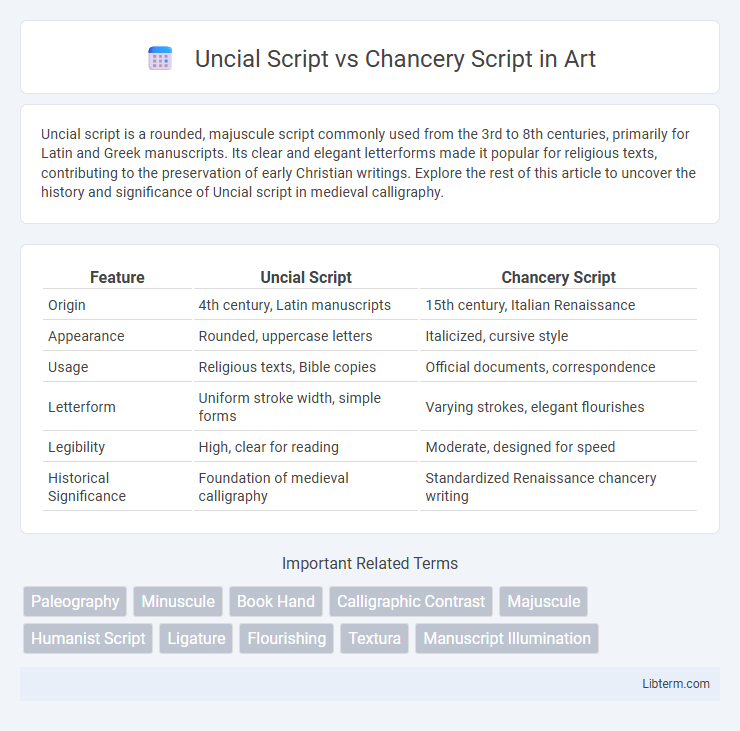Uncial script is a rounded, majuscule script commonly used from the 3rd to 8th centuries, primarily for Latin and Greek manuscripts. Its clear and elegant letterforms made it popular for religious texts, contributing to the preservation of early Christian writings. Explore the rest of this article to uncover the history and significance of Uncial script in medieval calligraphy.
Table of Comparison
| Feature | Uncial Script | Chancery Script |
|---|---|---|
| Origin | 4th century, Latin manuscripts | 15th century, Italian Renaissance |
| Appearance | Rounded, uppercase letters | Italicized, cursive style |
| Usage | Religious texts, Bible copies | Official documents, correspondence |
| Letterform | Uniform stroke width, simple forms | Varying strokes, elegant flourishes |
| Legibility | High, clear for reading | Moderate, designed for speed |
| Historical Significance | Foundation of medieval calligraphy | Standardized Renaissance chancery writing |
Introduction to Uncial and Chancery Scripts
Uncial Script, originating in the 4th century, is a majuscule writing style characterized by rounded, uniform letters commonly used in Latin and Greek manuscripts. Chancery Script, developed in the Renaissance period, is a cursive handwriting style recognized for its elegant, flowing strokes, primarily employed in official documents and correspondence. Both scripts played significant roles in historical manuscript traditions, with Uncial emphasizing clarity and formality and Chancery favoring speed and legibility.
Historical Origins of Uncial Script
Uncial script originated in the 3rd century AD as a majuscule writing style used primarily by Latin and Greek scribes during the late Roman Empire. It developed as a clear and rounded script ideal for writing on parchment, facilitating the transcription of religious manuscripts such as early Christian texts and Bibles. Unlike chancery script, which emerged later during the Renaissance as a cursive and more formal handwriting for legal and official documents, uncial maintained its distinctive curved and separated letterforms throughout medieval manuscript traditions.
The Development of Chancery Script
The development of Chancery Script emerged during the 15th century in Renaissance Italy as a more refined and legible form of handwriting, designed primarily for official documents and correspondence. It evolved from the earlier Gothic scripts and incorporated elements of humanist minuscule, blending clarity with elegance to meet the demands of bureaucratic efficiency. This script became the standard for administrative and legal writing across Europe, influencing modern typefaces and calligraphic traditions.
Key Features of Uncial Script
Uncial script is characterized by its rounded, uniform letterforms and lack of capital and lowercase distinction, with broad strokes and minimal ascenders or descenders, making it highly legible in manuscripts. Developed from Roman half-uncials between the 3rd and 8th centuries, it was widely employed in Latin and Greek religious texts due to its clarity and formality. Unlike the more angular and cursive chancery script, uncial maintains consistent height and spacing, contributing to its use in codices and sacred documents.
Distinctive Characteristics of Chancery Script
Chancery Script is distinguished by its elegant, flowing cursive style with well-defined, looped ascenders and descenders that enhance readability and speed of writing. Its letterforms are more rounded and connected compared to the angular, separate characters of Uncial Script, reflecting its historical use in court and administrative documents. The consistent slant and rhythmic spacing of Chancery Script contribute to its refined appearance, making it a preferred script for formal correspondence and official records.
Evolution and Timeline Comparisons
Uncial script, emerging around the 4th century, was primarily used in Latin and Greek manuscripts during the late Roman Empire and early Middle Ages, characterized by rounded, uniform letters suited for religious texts. Chancery script developed later, around the 15th century during the Italian Renaissance, evolving as a faster, more cursive handwriting style used for official documents and correspondence. The transition from Uncial's formal, block-like shapes to Chancery's flowing, connected letters reflects the broader shift from medieval manuscript traditions to early modern humanist scripts.
Usage in Manuscripts and Documents
Uncial script, characterized by rounded, majuscule letters, was predominantly used in Latin and Greek manuscripts from the 4th to the 8th centuries, especially for religious texts and early biblical codices. Chancery script, emerging in the 15th century, served as the formal handwriting of official documents, legal records, and royal decrees in Renaissance Europe, noted for its elegant, slanted, and cursive letterforms. While uncial script emphasized readability in handwritten manuscripts, chancery script prioritized speed and legibility for administrative and diplomatic correspondence.
Artistic and Calligraphic Impact
Uncial Script, characterized by its rounded and uniform letterforms, creates a bold and expressive artistic presence ideal for ancient manuscripts and religious texts, emphasizing clarity and grandeur. Chancery Script, with its elegant, flowing cursive strokes and refined letter connections, offers a sophisticated calligraphic style widely favored in formal documents and Renaissance artwork for its graceful readability. The distinct visual impact of Uncial's majuscule shapes contrasts with Chancery's dynamic slant and ornamental flourishes, shaping their artistic roles in historical and modern calligraphy.
Modern Applications and Influence
Uncial Script, characterized by its rounded, majuscule letterforms, remains influential in modern typography for creating a sense of historical authenticity and classical elegance in branding and calligraphy. Chancery Script, known for its flowing, cursive style developed during the Italian Renaissance, heavily influences contemporary cursive fonts used in invitations, certificates, and digital handwriting applications. Both scripts inspire modern typeface design by merging historical aesthetics with digital usability, enhancing visual communication in graphic design and digital media.
Conclusion: Uncial Script vs Chancery Script
Uncial Script features rounded, uniform letterforms primarily used in Latin and Greek manuscripts from the 4th to 8th centuries, characterized by its legibility and classical appearance. Chancery Script, developed during the Renaissance, exhibits more fluid, cursive strokes designed for speed and elegance in official documents, influencing modern calligraphy and typography. The choice between Uncial and Chancery scripts depends on the desired aesthetic, historical authenticity, and functional purpose in manuscript or design projects.
Uncial Script Infographic

 libterm.com
libterm.com